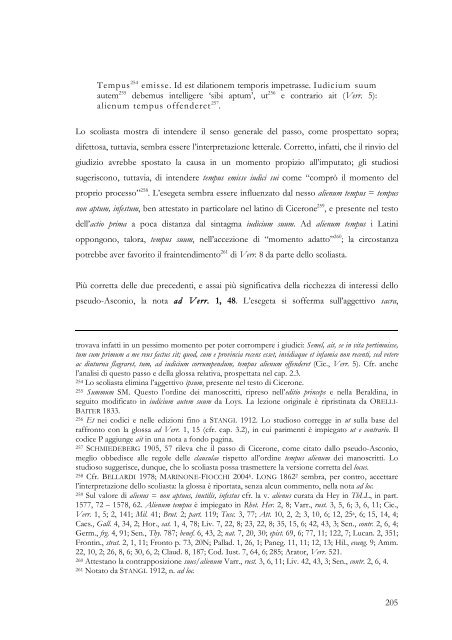3Eterov e)ce(te/rou sofo\v to/ te pa/lai to/ te nu=n. Ou ... - EleA@UniSA
3Eterov e)ce(te/rou sofo\v to/ te pa/lai to/ te nu=n. Ou ... - EleA@UniSA
3Eterov e)ce(te/rou sofo\v to/ te pa/lai to/ te nu=n. Ou ... - EleA@UniSA
You also want an ePaper? Increase the reach of your titles
YUMPU automatically turns print PDFs into web optimized ePapers that Google loves.
Tempus 254 emisse. Id est dilationem <strong>te</strong>mporis impetrasse. Iudicium suum<br />
au<strong>te</strong>m 255 debemus in<strong>te</strong>lligere ‘sibi aptum’, ut 256 e contrario ait (Verr. 5):<br />
alienum <strong>te</strong>mpus offenderet 257 .<br />
Lo scoliasta mostra di in<strong>te</strong>ndere il senso generale del <strong>pa</strong>sso, come prospetta<strong>to</strong> sopra;<br />
difet<strong>to</strong>sa, tuttavia, sembra essere l’in<strong>te</strong>rpretazione let<strong>te</strong>rale. Corret<strong>to</strong>, infatti, che il rinvio del<br />
giudizio avrebbe sposta<strong>to</strong> la causa in un momen<strong>to</strong> propizio all’imputa<strong>to</strong>; gli studiosi<br />
sugeriscono, tuttavia, di in<strong>te</strong>ndere <strong>te</strong>mpus emisse iudici sui come “comprò il momen<strong>to</strong> del<br />
proprio pro<strong>ce</strong>sso” 258 . L’esegeta sembra essere influenza<strong>to</strong> dal nesso alienum <strong>te</strong>mpus = <strong>te</strong>mpus<br />
non aptum, infestum, ben at<strong>te</strong>sta<strong>to</strong> in <strong>pa</strong>rticolare nel latino di Ci<strong>ce</strong>rone 259 , e presen<strong>te</strong> nel <strong>te</strong>s<strong>to</strong><br />
dell’actio prima a poca distanza dal sintagma iudicium suum. Ad alienum <strong>te</strong>mpus i Latini<br />
oppongono, talora, <strong>te</strong>mpus suum, nell’ac<strong>ce</strong>zione di “momen<strong>to</strong> adat<strong>to</strong>” 260 ; la circostanza<br />
potrebbe aver favori<strong>to</strong> il frain<strong>te</strong>ndimen<strong>to</strong> 261 di Verr. 8 da <strong>pa</strong>r<strong>te</strong> dello scoliasta.<br />
Più corretta delle due pre<strong>ce</strong>denti, e assai più significativa della ricchezza di in<strong>te</strong>ressi dello<br />
pseudo-Asconio, la nota ad Verr. 1, 48. L’esegeta si sofferma sull’aggettivo sacra,<br />
trovava infatti in un pessimo momen<strong>to</strong> per po<strong>te</strong>r corrompere i giudici: Semel, ait, se in vita pertimuisse,<br />
tum cum primum a me reus factus sit; quod, cum e provincia re<strong>ce</strong>ns esset, invidiaque et infamia non re<strong>ce</strong>nti, sed ve<strong>te</strong>re<br />
ac diuturna flagraret, tum, ad iudicium corrumpendum, <strong>te</strong>mpus alienum offenderet (Cic., Verr. 5). Cfr. anche<br />
l’analisi di ques<strong>to</strong> <strong>pa</strong>sso e della glossa relativa, prospettata nel cap. 2.3.<br />
254 Lo scoliasta elimina l’aggettivo ipsum, presen<strong>te</strong> nel <strong>te</strong>s<strong>to</strong> di Ci<strong>ce</strong>rone.<br />
255 Summum SM. Ques<strong>to</strong> l’ordine dei manoscritti, ripreso nell’editio prin<strong>ce</strong>ps e nella Beraldina, in<br />
segui<strong>to</strong> modifica<strong>to</strong> in iudicium au<strong>te</strong>m suum da Loys. La lezione originale è ripristinata da ORELLI-<br />
BAITER 1833.<br />
256 Et nei codici e nelle edizioni fino a STANGL 1912. Lo studioso corregge in ut sulla base del<br />
raffron<strong>to</strong> con la glossa ad Verr. 1, 15 (cfr. cap. 3.2), in cui <strong>pa</strong>rimenti è impiega<strong>to</strong> ut e contrario. Il<br />
codi<strong>ce</strong> P aggiunge ait in una nota a fondo <strong>pa</strong>gina.<br />
257 SCHMIEDEBERG 1905, 57 rileva che il <strong>pa</strong>sso di Ci<strong>ce</strong>rone, come cita<strong>to</strong> dallo pseudo-Asconio,<br />
meglio obbedis<strong>ce</strong> alle regole delle clausulae rispet<strong>to</strong> all’ordine <strong>te</strong>mpus alienum dei manoscritti. Lo<br />
studioso suggeris<strong>ce</strong>, dunque, che lo scoliasta possa trasmet<strong>te</strong>re la versione corretta del locus.<br />
258 Cfr. BELLARDI 1978; MARINONE-FIOCCHI 2004 6. LONG 1862 2 sembra, per contro, ac<strong>ce</strong>ttare<br />
l’in<strong>te</strong>rpretazione dello scoliasta: la glossa è riportata, senza alcun commen<strong>to</strong>, nella nota ad loc.<br />
259 Sul valore di alienus = non aptuus, inutilis, infestus cfr. la v. alienus curata da Hey in ThLL, in <strong>pa</strong>rt.<br />
1577, 72 – 1578, 62. Alienum <strong>te</strong>mpus è impiega<strong>to</strong> in Rhet. Her. 2, 8; Varr., rust. 3, 5, 6; 3, 6, 11; Cic.,<br />
Verr. 1, 5; 2, 141; Mil. 41; Brut. 2; <strong>pa</strong>rt. 119; Tusc. 3, 77; Att. 10, 2, 2; 3, 10, 6; 12, 25 a, 6; 15, 14, 4;<br />
Caes., Gall. 4, 34, 2; Hor., sat. 1, 4, 78; Liv. 7, 22, 8; 23, 22, 8; 35, 15, 6; 42, 43, 3; Sen., contr. 2, 6, 4;<br />
Germ., frg. 4, 91; Sen., Thy. 787; benef. 6, 43, 2; nat. 7, 20, 30; epist. 69, 6; 77, 11; 122, 7; Lucan. 2, 351;<br />
Frontin., strat. 2, 1, 11; Fron<strong>to</strong> p. 73, 20N; Pallad. 1, 26, 1; Paneg. 11, 11; 12, 13; Hil., evang. 9; Amm.<br />
22, 10, 2; 26, 8, 6; 30, 6, 2; Claud. 8, 187; Cod. Iust. 7, 64, 6; 285; Ara<strong>to</strong>r, Verr. 521.<br />
260 At<strong>te</strong>stano la contrapposizione suus/alienum Varr., rust. 3, 6, 11; Liv. 42, 43, 3; Sen., contr. 2, 6, 4.<br />
261 Nota<strong>to</strong> da STANGL 1912, n. ad loc.<br />
205
















